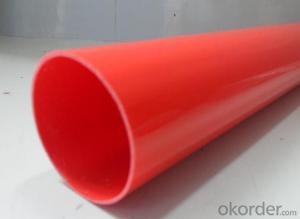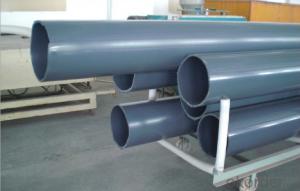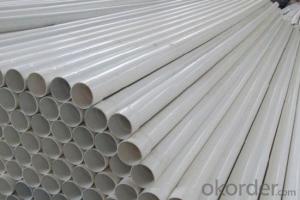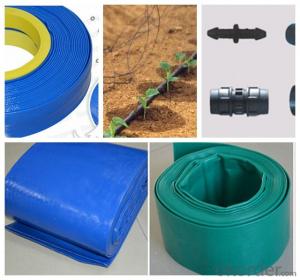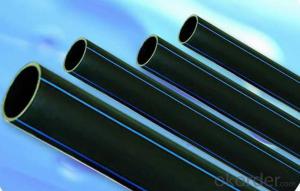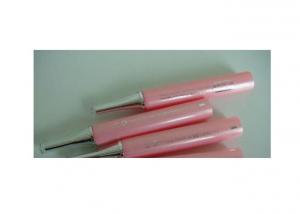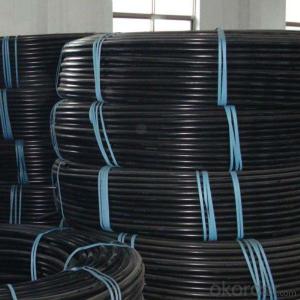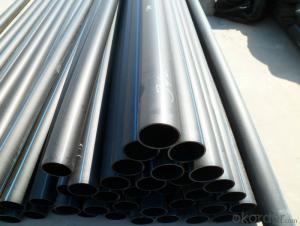Plastic Tubes HDPE Pipe ISO4427-2000 DN90
- Loading Port:
- China Main Port
- Payment Terms:
- TT OR LC
- Min Order Qty:
- -
- Supply Capability:
- -
OKorder Service Pledge
OKorder Financial Service
You Might Also Like
Physical properties[edit]
Polyethylene is a thermoplasticpolymer consisting of long hydrocarbon chains. Depending on the crystallinity and molecular weight, a melting point and glass transition may or may not be observable. The temperature at which these occur varies strongly with the type of polyethylene. For common commercial grades of medium- and high-density polyethylene the melting point is typically in the range 120 to 180 °C (248 to 356 °F). The melting point for average, commercial, low-density polyethylene is typically 105 to 115 °C (221 to 239 °F).it is transprant.
Chemical properties[edit]
Most LDPE, MDPE and HDPE grades have excellent chemical resistance, meaning that it is not attacked by strong acids or strong bases. It is also resistant to gentle oxidants and reducing agents. Polyethylene burns slowly with a blue flame having a yellow tip and gives off an odour of paraffin. The material continues burning on removal of the flame source and produces a drip.[3] Crystalline samples do not dissolve at room temperature. Polyethylene (other than cross-linked polyethylene) usually can be dissolved at elevated temperatures in aromatic hydrocarbons such as toluene or xylene, or in chlorinated solvents such as trichloroethane or trichlorobenzene.[4]
GB/T13663-2000:
| PE63管材规格 | |||||
| 公称 外径dn,mm | SDR33 | SDR26 | SDR17.6 | SDR13.6 | SDR11 |
| 公称压力 PN,Mpa | |||||
| 0.32 | 0.4 | 0.6 | 0.8 | 1.0 | |
| 公称 壁厚 | 公称 壁厚 | 公称 壁厚 | 公称 壁厚 | 公称 壁厚 | |
| 16 | 2.3 | ||||
| 20 | 2.3 | 2.3 | |||
| 25 | 2.3 | 2.3 | 2.3 | ||
| 32 | 2.3 | 2.4 | 2.9 | ||
| 40 | 2.3 | 2.3 | 3.0 | 3.7 | |
| 50 | 2.3 | 2.9 | 3.7 | 4.6 | |
| 63 | 2.3 | 2.5 | 3.6 | 4.7 | 5.8 |
| 75 | 2.3 | 2.9 | 4.3 | 5.6 | 6.8 |
| 90 | 2.8 | 3.5 | 5.1 | 6.7 | 8.2 |
| 110 | 3.4 | 4.2 | 6.3 | 8.1 | 10.0 |
| 125 | 3.9 | 4.8 | 7.1 | 9.2 | 11.4 |
| 140 | 4.3 | 5.4 | 8.0 | 10.3 | 12.7 |
| 160 | 4.9 | 6.2 | 9.1 | 11.8 | 14.6 |
| 180 | 5.5 | 6.9 | 10.2 | 13.3 | 16.4 |
| 200 | 6.2 | 7.7 | 11.4 | 14.7 | 18.2 |
| 225 | 6.9 | 8.6 | 12.8 | 16.6 | 20.5 |
| 250 | 7.7 | 9.6 | 14.2 | 18.4 | 22.7 |
| 280 | 8.6 | 10.7 | 15.9 | 20.6 | 25.4 |
| 315 | 9.7 | 12.1 | 17.9 | 23.2 | 28.6 |
| 355 | 10.9 | 13.6 | 20.1 | 26.1 | 32.2 |
| 400 | 12.3 | 15.3 | 22.7 | 29.4 | 36.3 |
| 450 | 13.8 | 17.2 | 25.5 | 33.1 | 40.9 |
| 500 | 15.3 | 19.1 | 28.3 | 36.8 | 45.4 |
| 560 | 17.2 | 21.4 | 31.7 | 41.2 | 50.8 |
| 630 | 19.3 | 24.1 | 35.7 | 46.3 | 57.2 |
- Q: Where do I find a metal magazine tube follower for a remington 1187?? All i can find are plastic!!!?
- Most new ones are plastic. Here is one.
- Q: Can plastic tubes be customized with logos or labels?
- Yes, plastic tubes can be easily customized with logos or labels. This can be done through various methods such as printing, engraving, or attaching labels onto the tubes. Customizing plastic tubes with logos or labels helps businesses to enhance their branding and product identification.
- Q: How do you clean clogged plastic tubes?
- To clean clogged plastic tubes, you can try a few methods. First, try using a plunger to create pressure and dislodge the clog. If that doesn't work, you can use a mixture of hot water and dish soap to break down any grease or grime causing the clog. Alternatively, you can try using a pipe snake or a wire hanger bent into a hook shape to physically remove the blockage.
- Q: Can plastic tubes be used for veterinary products?
- Yes, plastic tubes can be used for veterinary products. They are commonly used for various applications such as storing and dispensing medications, collecting and transporting samples, and administering fluids to animals. Plastic tubes are convenient, versatile, and can be designed to meet the specific needs of veterinary products while ensuring safety and hygiene.
- Q: I went on vacation a year ago for two weeks and came home to a refrigerator that no longer has a working water spout. The ice machine still works and the the motor comes on when I place a glass under the water spout bit no water comes out? I do have hard water. Could it be blocked from calcification? I figure vinegar is my last hope. Please help.
- Vinegar will not harm the system, the defect is blocked pipe line, this need to be rectified, the best and simple solution will be to get a handy man familiar with fridge, this will solve You a lot of frustration. although saving is important but guess in this it cannot be avoided, best of luck
- Q: where would be a good place to start looking? recycling places? arts and crafts? home depot? Im just looking for something rather cheap.
- Try PVC piping hard to find it in clear normally comes in white/grey but this am sure will do it you. Good luck
- Q: How are plastic tubes labeled with lot numbers?
- Plastic tubes are typically labeled with lot numbers using various methods such as direct printing, adhesive labels, or laser engraving. The lot numbers are applied to ensure traceability and quality control, allowing manufacturers to track and monitor the tubes' production details, such as the materials used, date of manufacture, and potential defects, if any.
- Q: How do plastic tubes perform in high-altitude environments?
- Plastic tubes generally perform well in high-altitude environments as they are lightweight, durable, and resistant to extreme temperatures. However, it is important to choose tubes made from materials that are specifically designed to withstand the conditions of high-altitude environments, as some plastics may become brittle or degrade under low atmospheric pressure.
- Q: What are the different wall thicknesses available for plastic tubes?
- The different wall thicknesses available for plastic tubes can vary depending on the specific requirements and applications. Generally, plastic tubes can range from thin-walled with thicknesses as low as 0.5mm, to medium-walled with thicknesses between 1mm to 3mm, and even thick-walled tubes with thicknesses exceeding 3mm. The choice of wall thickness depends on factors such as the intended use, structural requirements, and desired flexibility or rigidity of the tube.
- Q: i have to know, because otherwise the hoover is rendered completely useless, the bottle cap is the same size as the hoover tube and i do not have a stick or long object long enough with which to poke it out :(please help me
- Have you tried blowing it out. Wipe the opening on the opposite side of the tube where the cap is with some rubbing alcohol till it's clean and let dry. Then take a deep breath and blow through the tube, sealing the tube by pressing it against your face. This should dislodge the cap enough to where you should be able to shake the cap out.
Send your message to us
Plastic Tubes HDPE Pipe ISO4427-2000 DN90
- Loading Port:
- China Main Port
- Payment Terms:
- TT OR LC
- Min Order Qty:
- -
- Supply Capability:
- -
OKorder Service Pledge
OKorder Financial Service
Similar products
Hot products
Hot Searches
Related keywords





